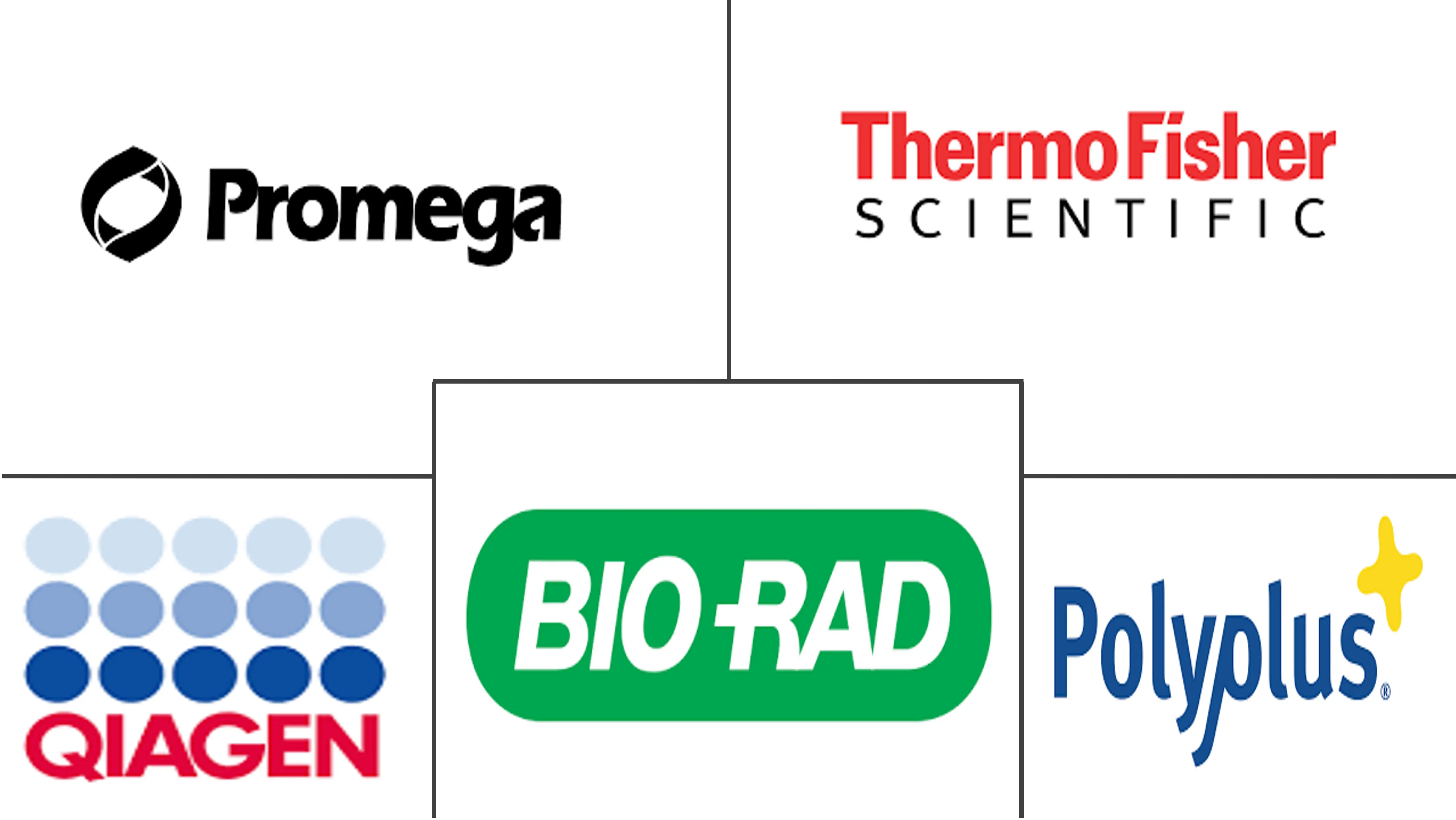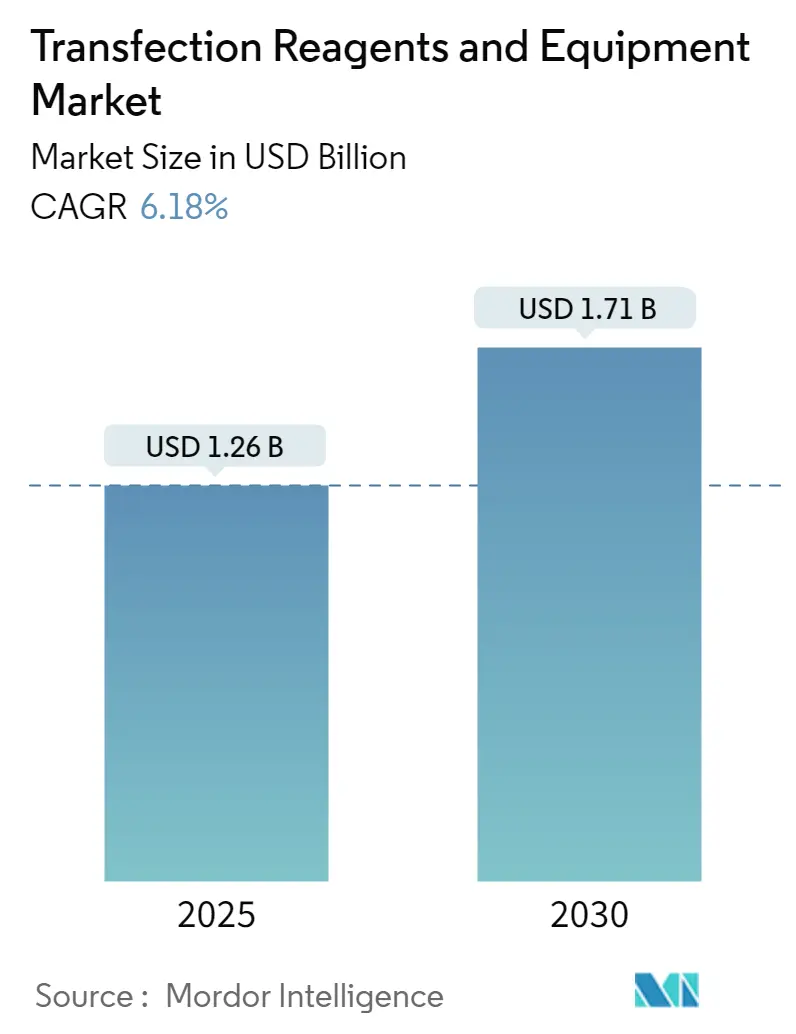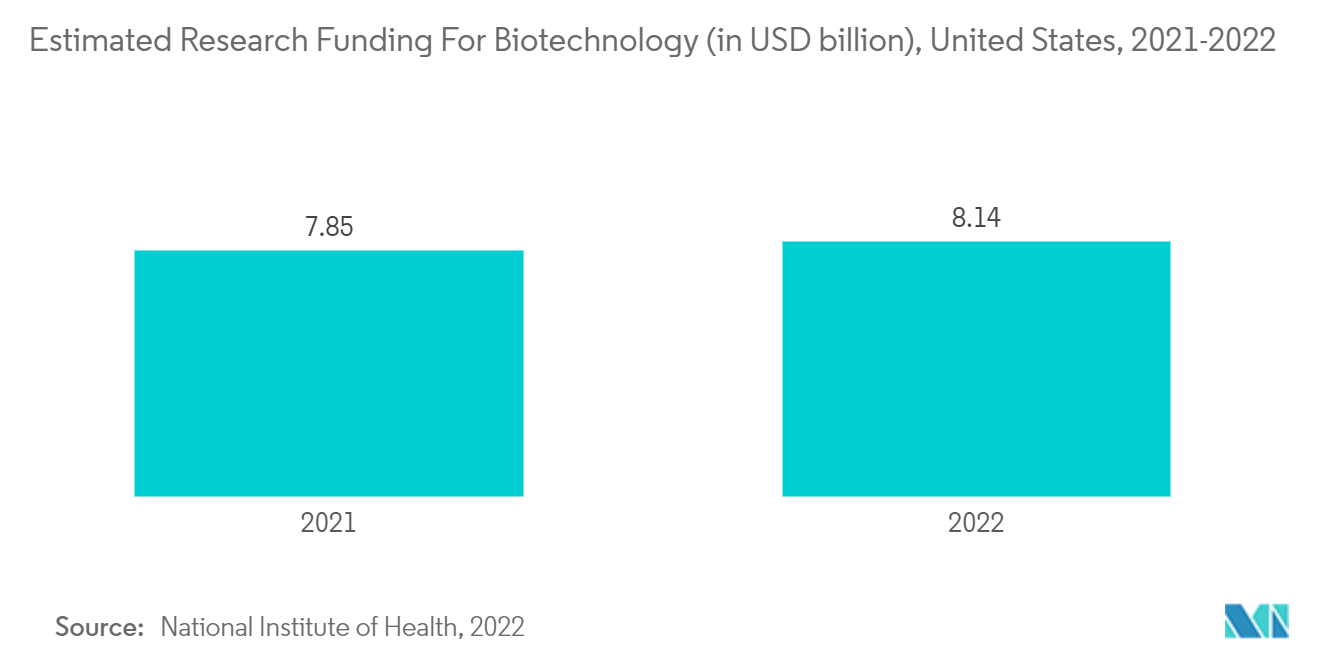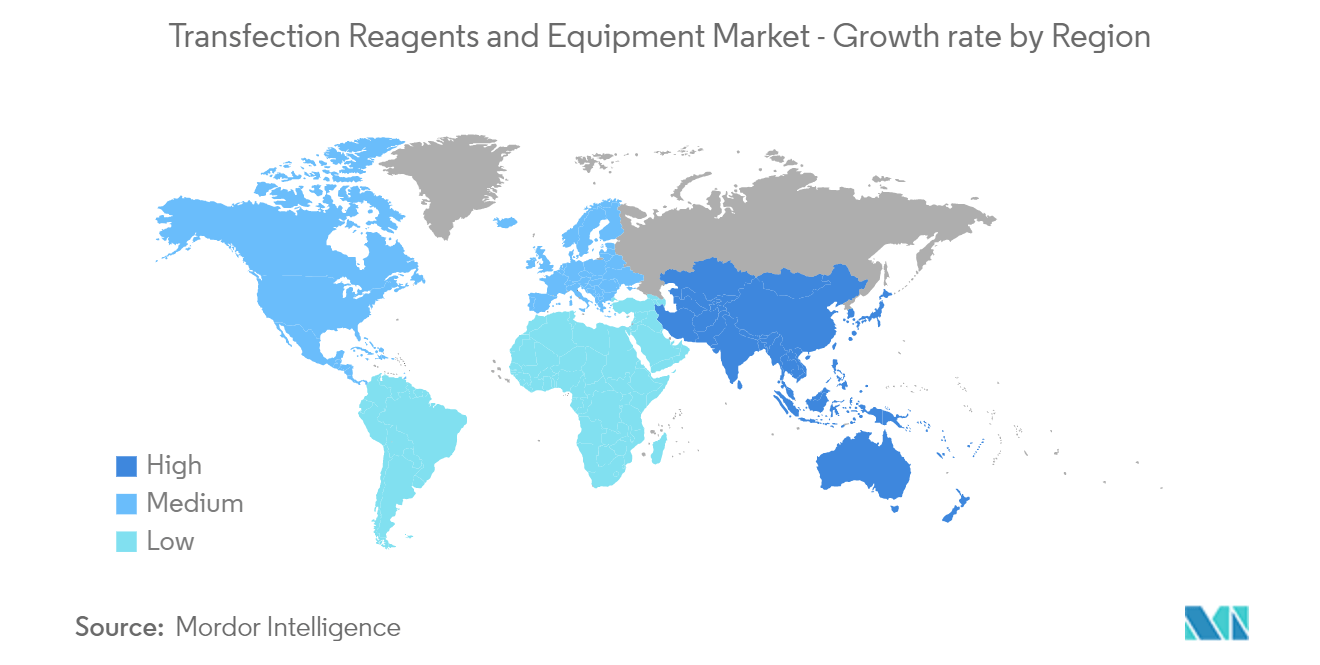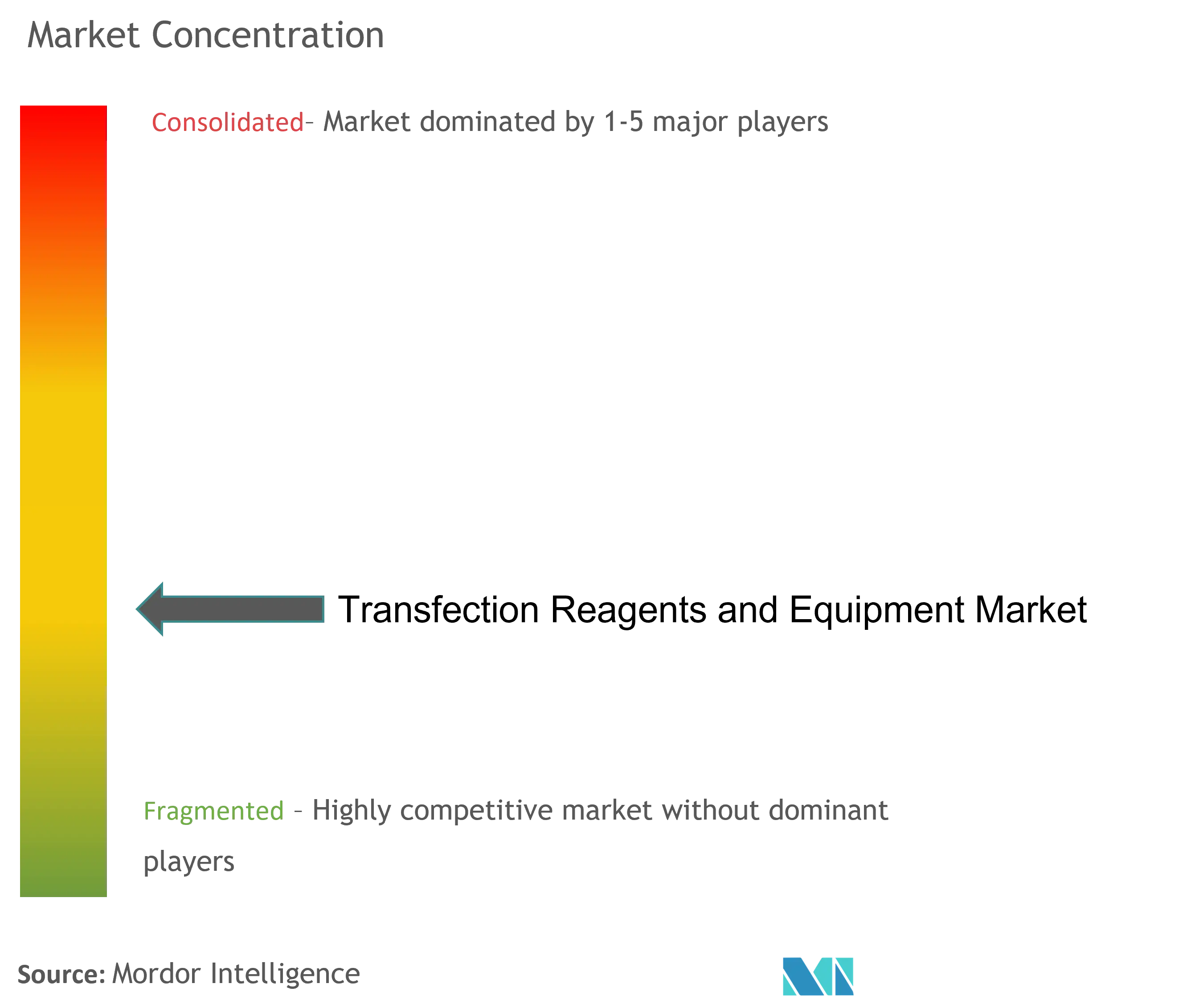Transfection Reagents and Equipment Market Analysis
The Transfection Reagents and Equipment Market size is estimated at USD 1.26 billion in 2025, and is expected to reach USD 1.71 billion by 2030, at a CAGR of 6.18% during the forecast period (2025-2030).
Many companies developing COVID-19 vaccines were using Viral transfection methods, such as viral vectors, to ensure effective vaccine delivery. However, the production of viral vectors was a cumbersome and challenging process, and any improvement to that process could result in more vaccines being made available faster. The viral vector-producing cells need to be transfected with multiple plasmids carrying various viral genes and the vaccine. For instance, according to an article published by PubMed in July 2022, a transfection procedure using specific Transfection reagents was employed for the purification of the SARS-CoV-2 spike (S) protein ectodomain. As the research and development of COVID-19 vaccines gained pace during the initial pandemic, transfection reagents and equipment were increasingly used in the production and research of vaccines. Thus, the pandemic had a significant impact on the market growth; however, as the pandemic has subsided currently, the studied market is expected to have stable growth during the forecast period of the study.
The major factors driving the market growth include technological advancements in Transfection technology, increased R&D expenditure and activities by pharmaceutical and biotech companies, and a rise in demand for synthetic genes.
The introduction of transfection technologies has laid the foundation for the Genetic modification of several causative agents of diseases. The technological advancements in transfection procedures are a major factor driving the market growth. For instance, according to an article published by PubMed Central in October 2022, it has been observed that recent strategies have been developed to improve human mesenchymal stem cell (hMSC) transfection by innovating nanocarriers, Nucleic acid delivery systems, and by priming hMSCs chemically and physically for more efficient transfection. Thus, these types of technological advancements in transfection are expected to boost the market growth.
Moreover, the increasing R&D expenditure and research activities by pharmaceutical and biotech companies are also expected to boost market growth. For instance, according to the 2021 annual report of Pfizer Inc., the company invested USD 13,829 million in FY 2021, which increased heavily as compared to USD 9,343 million in the previous year. Similarly, as per a press release published in April 2022 by Biocon Biologics Limited, a subsidiary of biopharmaceutical market player Biocon, the company expects its R&D expenses to increase heavily between 10-15% in the next financial year (FY 2023), as the company is advancing its pipeline to drive future growth. Thus, the rising R&D expenditure of such pharmaceutical and biotechnology companies is expected to boost market growth.
Additionally, the rising developments by various market players are also expected to boost market growth. For instance, in May 2021, Lonza Group AG launched the next generation of its popular Nucleofector Platform. Nucleofector Technology is an effective Non-viral transfection method, which can be used even for hard-to-transfect cells, such as primary cells and pluripotent stem cells.
Hence, the aforementioned factors such as the rising technological advancements in transfection, rising R&D expenditure of such pharmaceutical and biotechnology companies, and the increasing developments by various market players are expected to boost the market growth. However, the high cost of Transfection reagents and selective effectiveness and certain limitations of transfection reagents can restrain the market growth over the forecast period.
Transfection Reagents and Equipment Market Trends
Pharmaceutical & Biotechnology Companies Segment is Expected to Hold a Significant Share in the Market Over the Forecast Period
The use of biopharmaceutical products has remarkably increased over the years for the treatment of multiple pathological conditions, such as genetic diseases and cancer. With the growing burden of diseases, the need for early diagnosis and treatments also increases. Pharmaceutical and biotechnology companies have increased their investment and research for such therapies, and as Transfection reagents and equipment, including Transfection kits and systems, are highly required in such research processes, the increasing demand for these tools is expected to enhance the segment's growth.
The increasing research and development expenses by various pharmaceutical and biotechnology companies are a major factor driving the segment's growth. For instance, as per the annual report 2021 of Novartis AG, one of the global market players in the pharmaceutical industry, the company invested USD 14,886 million in R&D in FY 2021, which increased from USD 14,197 million in the previous year. Similarly, according to the annual report of Eli Lilly and Company in 2021, the research and development expenses of the company increased to USD 7,025.9 million in 2021, which is significantly higher compared to USD 6,085.7 million in R&D expenses in the previous year.
Additionally, research and development collaborations for the development of new genetic products involving Gene expression and Genetic modification are also expected to enhance the segment's growth. For instance, in December 2022, Eli Lilly and Company and ProQR Therapeutics N.V. announced the expansion of their licensing and collaboration agreement focused on the discovery, development, and commercialization of new genetic medicines.
Thus, the aforementioned factors such as the increasing research and development expenses and the increasing collaborations and agreements for developing newer genetic products are expected to boost the segment's growth in the Transfection reagents and equipment market.
North America is Expected to Hold a Significant Share in the Market Over the Forecast Period
Factors such as increasing investments in research and development in genomics, increasing healthcare expenditure, rising developments by major market players, and the availability of advanced technologies are expected to fuel market growth in North America.
For instance, in September 2021, the National Institutes of Health awarded USD 16 million to the University of Washington School of Medicine's scientists and their collaborators to fund two projects within the consortium. The first project aims at studying the more than one million known regulatory elements in the genome and their variants to determine how they affect Gene expression. The second project aims at studying the effect of about 200,000 single nucleotide variants, which contain a change of a single DNA molecule in a gene sequence in about 32 genes that are witnessed in specific diseases, including cancer.
Similarly, in October 2022, the Government of Canada invested over USD 5.6 million to help early-stage genomics companies bring new products to market. Thus, the rising investments in genomic research are expected to boost the market growth in the region.
Moreover, the rising developments by key market players are also expected to enhance market growth. For instance, in August 2021, Mirus Bio, a United States-based company, expanded its TransIT VirusGen platform, which is compliant with good manufacturing practices (GMP) Viral transfection manufacturing, to support cell and gene therapy development, process activities, and commercial production. The expansion, referred to as TransIT VirusGen GMP Transfection reagent, is designed to enhance the Nucleic acid delivery of packaging and transfer vector DNA to suspension and adherent HEK 293 cell types to increase the production of recombinant adeno-associated virus and lentivirus vectors.
Thus, the aforementioned factors such as the increasing funding for genomics research and the increasing developments by key market players are expected to boost the Transfection reagents market growth in the region.
Transfection Reagents and Equipment Industry Overview
The Transfection reagents and equipment market is moderately competitive and consists of a number of major players. Companies like Bio-Rad Laboratories, Lonza Group, MaxCyte Inc., Merck KGaA, Mirus Bio, Polyplus-transfection SA, Promega Corporation, QIAGEN NV, Thermo Fisher Scientific Inc., among others, hold a substantial share in the Transfection reagents and equipment market.
Transfection Reagents and Equipment Market Leaders
-
Bio-Rad Laboratories
-
Polyplus-transfection SA
-
Promega Corporation
-
Qiagen N.V.
-
Thermo Fisher Scientific
- *Disclaimer: Major Players sorted in no particular order
Transfection Reagents and Equipment Market News
- In October 2022, Aragen Life Sciences (Aragen) launched its newly optimized RapTr 2022 cell line development (CLD) platform. The RapTr2022 offers a 33% reduction in CLD timelines and delivers increased titers up to 6g/l. This royalty-free platform accelerates the process of cell line engineering from DNA transfection in the host cell lines to Research Cell Bank (RCB) within 18 weeks.
- In September 2022, Polyplus launched in vivo-jetRNA+ transfection reagent for in vivo mRNA delivery using preformed liposome formulation.
Transfection Reagents and Equipment Industry Segmentation
As per the scope of the report, transfection refers to the process of artificially introducing nucleic acids (DNA or RNA) into eukaryotic cells. Such introductions of foreign nucleic acid using various chemical, biological, or physical methods can result in changing the properties of the cell, allowing the study of gene function and protein expression in the context of the cell. The reagents and equipment used in this procedure are referred to as transfection reagents and equipment. The transfection reagents and equipment market is segmented by product (reagents and equipment), by method (biochemical method, physical methods, and viral methods), by end-user (pharmaceutical and biotechnology companies, and academics and research institutes, and others), and by geography (North America, Europe, Asia-Pacific, Middle East and Africa, and South America). The report also covers the estimated market sizes and trends for 17 different countries across major regions globally. The report offers the value (in USD million) for the above segments.
| By Product | Reagents | ||
| Equipment | |||
| By Method | Biochemical Methods | ||
| Physical Methods | |||
| Viral Methods | |||
| By End User | Pharmaceutical & Biotechnology Companies | ||
| Academics & Research Institutes | |||
| Others | |||
| Geography | North America | United States | |
| Canada | |||
| Mexico | |||
| Europe | Germany | ||
| United Kingdom | |||
| France | |||
| Italy | |||
| Spain | |||
| Rest of Europe | |||
| Asia-Pacific | China | ||
| Japan | |||
| India | |||
| Australia | |||
| South Korea | |||
| Rest of Asia-Pacific | |||
| Middle East and Africa | GCC | ||
| South Africa | |||
| Rest of Middle East and Africa | |||
| South America | Brazil | ||
| Argentina | |||
| Rest of South America | |||
Transfection Reagents and Equipment Market Research FAQs
How big is the Transfection Reagents and Equipment Market?
The Transfection Reagents and Equipment Market size is expected to reach USD 1.26 billion in 2025 and grow at a CAGR of 6.18% to reach USD 1.71 billion by 2030.
What is the current Transfection Reagents and Equipment Market size?
In 2025, the Transfection Reagents and Equipment Market size is expected to reach USD 1.26 billion.
Who are the key players in Transfection Reagents and Equipment Market?
Bio-Rad Laboratories, Polyplus-transfection SA, Promega Corporation, Qiagen N.V. and Thermo Fisher Scientific are the major companies operating in the Transfection Reagents and Equipment Market.
Which is the fastest growing region in Transfection Reagents and Equipment Market?
Asia-Pacific is estimated to grow at the highest CAGR over the forecast period (2025-2030).
Which region has the biggest share in Transfection Reagents and Equipment Market?
In 2025, the North America accounts for the largest market share in Transfection Reagents and Equipment Market.
What years does this Transfection Reagents and Equipment Market cover, and what was the market size in 2024?
In 2024, the Transfection Reagents and Equipment Market size was estimated at USD 1.18 billion. The report covers the Transfection Reagents and Equipment Market historical market size for years: 2019, 2020, 2021, 2022, 2023 and 2024. The report also forecasts the Transfection Reagents and Equipment Market size for years: 2025, 2026, 2027, 2028, 2029 and 2030.
Our Best Selling Reports
Transfection Reagents and Equipment Industry Report
The Transfection Reagents and Equipment Market is segmented by product, method, end user, and geography. The market size and forecast are provided in terms of value for the segments mentioned. The market analysis includes a forecast outlook and a historical overview.
Industry reports indicate that the market segmentation covers various products such as reagents and equipment, methods including biochemical, physical, and viral methods, and end users like pharmaceutical and biotechnology companies, academics and research institutes, and others. The industry analysis and market forecast suggest significant growth in the transfection reagents and equipment market.
Market leaders in this industry are contributing to the market growth with innovative solutions and technologies. The market trends and industry information point towards a positive industry outlook, with substantial market value and industry size. The market review highlights the importance of research companies in driving market growth.
The industry research and industry statistics provide a comprehensive market overview, detailing market data and market predictions. The market outlook and industry trends emphasize the ongoing developments and future potential within the market. The report example and report pdf offer detailed insights into the market dynamics and industry sales.
Overall, the transfection reagents and equipment market is poised for growth, driven by advancements in technology and increased demand from various end users. The market segmentation and market forecast highlight the key areas of focus for industry players, ensuring a thorough understanding of market value and market data.

